서 론
블루베리는 진달래과(Ericaceae) 산앵두나무속(Vaccinium)에 속하는 관목성 식물로서 세계적으로 400여 종이 알려져 있다[1]. 북아메리카 원산지의 블루베리는 낙엽성 또는 상록성 과수로서 키가 작게 자라는 관목형이 대부분이나, 일부 품종은 성목으로 자라 5 m에 달하는 것도 있다. 블루베리는 온도 15°C–21°C와 pH 4.5–5의 산성토양에서 잘 자라는 다년생 온대 과수이다. 북미에서 재배되는 주요 블루베리 종은 highbush blueberry(Vaccinium corymbosum), lowbush blueberry (Vaccinium angustifolium) 및 rabbiteye blueberry(Vaccinium ashei) 등 세 종류가 상업적으로 중요한 과실로 있다[1]. 우리나라에서는 주로 highbush blueberry(V. corymbosum)가 재배되고 있다[2]. 블루베리는 병충해가 적어 무농약으로도 재배할 수 있는 친환경적 작물로 알려져 있다[3,4]. 열매는 둥글고 하나의 무게는 1–1.5 g이며, 색은 짙은 하늘색, 붉은빛을 띤 갈색 또는 검은색이다. 블루베리는 당도가 높고 풍미가 진하며, 비타민 그리고 각종 미네랄이 풍부하다. 신선한 블루베리의 일반성분은 수분함량 10.47%, 단백질 2.66%, 지방 2.04%, 가용성 무기질 81.36%, 식이섬유 1.48%, 그리고 회분 1.99%로 분석되었다[5]. 블루베리 성숙 과실에는 anthocyanins, caffeic (caffeic acid), chlorogenic(chlorogenic acid), p-coumaric, ferulic acid 등의 폴리페놀성 물질과 플라보노이드(flavonoid)가 풍부하게 함유되어 있다[6,7]. 블루베리의 생리활성은 다량의 안토시아닌에 기인한다[8]. 안토시아닌은 항산화 효과가 뛰어나 질병예방 및 노화를 예방한다고 보고되어 있다[9–12]. 그 외의 효과로는 항알레르기성, 항당뇨, 이뇨작용, 항고혈압, 항염증, 항균, 항암, 혈소판 응집 억제, 심혈관 질환, 알츠하이머에 의한 뇌손상의 예방 등이 보고되어 있다[13–21].
유산균(lactic acid bacteria) 그람 양성 박테리아, 막대 또는 구균 모양의 세포, 음성 카탈라아제, 미호기성, 비포자성, 비운동성이며, 탄수화물 발효의 최종 결과로 유산을 생성한다[22]. 유산균은 타액, 내장, 유제품, 육제품 등에 서식하는 동물유래 유산균(animal origin lactic acid bacteria)과 김치, 과일, 막걸리 등의 발효식품에서 분리된 식물유래 유산균(plant origin lactic acid bacteria)으로 분류한다[23,24]. 유산균은 분해되는 유기 물질의 악취 저감 효과, 식품의 맛 개선, 저장 중 부패미생물의 성장을 억제하기 때문에 식품 보존에 효과적으로 이용되고 있다[25].
최근, 식물유래 유산균은 gamma-amino butyric acid 생성, 면역력 증진, 항균물질 생산, 고지혈증 및 지방간 개선, 체지방 억제, 아토피 개선 등 다양한 건강 기능성을 가지고 있어서 예방 의학적인 측면에서 크게 각광받고 있다. 따라서 본 연구는 블루베리로부터 유산균을 분리·동정하고, 동정된 유산균의 배양 상징액으로부터 병원성균에 대한 항균 활성을 확인하였다.
재료 및 방법
병원성 균주 Escherichia coli KCCM 11569, E. coli KCCM 11587, E. coli KCCM 11591, E. coli KCCM 11596, 그리고 E. coli KCCM 11600은 한국 미생물 보존 센터에서 구입하였다. 그리고 Salmonella Enteritidis NCCP 16947, Salmonella Thompson NCCP 11704, Salmonella Typhimurium NCCP 16960은 국가 병원체 자원은행에서 구입하여 실험에 사용하였다. Escherichia와 Salmonella는 Luria-Bertani(LB) broth(Difco, USA)를 사용하여 37°C의 항온기에서 배양하였다.
블루베리(V. corymbosum L.)로부터 유산균은 37°C 항온기에서 6주간 혐기발효에 의해서 분리하였다. 발효가 끝난 블루베리는 멸균 증류수를 첨가하여 균질한 후, 유산균을 분리하였다. 유산균을 분리하기 위해 0.01% sodium azide(Sigma-Aldrich, USA)가 첨가된 De Man Rogosa-Sharpe (Difco) agar에 균질한 블루베리 액을 도말하였다. 도말한 MRS agar를 37°C에서 콜로니가 형성될 때까지 혐기 또는 호기 배양하였다. 형성된 콜로니는 모양, 크기 및 그람염색법을 통하여 유산균을 선택하였다. 선택된 유산균은 수탁업체(Sogent, Korea)에 의뢰하여 동정하였다.
MRS broth에서 24시간 동안 사전 배양한 분리 유산균을 5%(w/v) defibrinated whole sheep blood(Kisan Biotech Co., Korea)를 함유한 Blood Agar Base(Kisan Biotech, Korea)에 옮기고, 37°C에서 48시간 배양하였다. 용혈 활성은 콜로니 주위의 가수 분해 맑은 영역(β-용혈), 콜로니 주변의 부분 가수 분해 및 녹색 색조 영역(α-용혈), 또는 콜로니 주위의 영역 없음(용혈 γ)을 관찰하였다. γ-용혈은 음성으로 간주하였다.
블루베리로부터 분리한 유산균을 MRS broth에 접종한 후, 37°C에서 24시간 동안 배양하였다. 배양이 완료된 후, 유산균의 배양액을 20분 동안 얼음에 정치한 뒤 원심분리기(Hanil, Korea)를 이용하여 4°C에서 4,000 rpm으로 20분간 원심분리하여 상징액을 회수하였다. 얻어진 상징액은 Syringe filter 0.45 μm와 0.22 μm(Advantec, Japan)를 사용하여 여과한 후, –20°C에 보관하면서 실험에 사용하였다.
블루베리로부터 분리된 유산균의 상징액의 병원성균에 대한 항균활성 여부는 paper disc를 이용한 확산법으로 확인하였다. 20 mL의 LB agar는 125°C에서 20분 멸균하였고, 배지 온도를 50°C까지 냉각 후, 각각의 병원성균인 S. Enteritidis NCCP 16947, S. Thompson NCCP 11704, S. Typhimurium NCCP 16960, E. coli KCCM 11569, E. coli KCCM 11587, E. coli KCCM 11591, E. coli KCCM 11596, 그리고 E. coli KCCM 11600를 각각 1% 접종하였다. Petri dish에 굳어진 각각의 병원성균에 분리된 유산균 배양 상징액을 40, 20, 10, 그리고 5 μL의 농도로 조정하여 멸균된 paper disc(Advantec)에 흡수시켜 37°C에 배양하면서 항균활성을 측정하였다.
블루베리 유래 유산균 배양 상징액의 병원성균에 대한 농도별 항균 활성을 확인하기 위해 96 well plate 법을 이용하여 측정하였다. 유산균 배양 상징액을 각 LB배지에 20%, 10%, 5%, 2.5% 농도로 조정하여 첨가하였다. 그리고 예비 배양한 각각의 병원성균을 1% 접종하였다. 병원성균의 성장은 37°C에서 배양하면서 3시간 간격으로 Microplate Reader(Bio-Rad, USA)를 이용하여 655 nm의 파장에서 흡광도(optical density)를 측정하였다.
블루베리 유래 유산균으로부터 얻어진 배양 상징액의 항균활성이 열과 pH에 안정성이 있는지를 확인하였다. 열 안정성 시험은 분리된 유산균의 배양 상징액을 각각 65°C에서 30 min, 75°C에서 15 min, 85°C에서 10 min, 100°C에서 5 min의 조건으로 열처리한 후, 5% 첨가에 의해서 병원성균에 대한 항균활성을 측정하였다. 그리고 pH 변화에 대한 항균활성 여부는 1N NaOH를 이용하여 배양 상징액을 pH 7.0으로 조정한 후, 배양액에 5% 첨가에 의해서 병원성균에 대한 항균활성을 측정하였다. 각각의 병원성균의 성장은 37°C에서 24시간동안 배양하면서 6시간 간격으로 흡광도를 측정하여 확인하였다.
결과 및 고찰
블루베리로부터 유산균의 분리는 37°C 항온기에서 6주간 혐기발효에 의해서 수행되었다. 발효가 끝난 블루베리를 멸균 증류수를 첨가하여 균질한 후, MRS agar에 도말하여 37°C에서 콜로니가 형성될 때까지 혐기 또는 호기 배양하였다. 얻어진 콜로니는 모양, 크기 및 그람염색법을 통하여 유산균을 선택하였다. 선택된 유산균은 간상의 형태와 그람 양성을 보여주었다(Fig. 1). 선택된 유산균의 미생물 동정을 확인한 결과, Lactiplantibacillus argentoratensis strain DKO 22와 99%의 상동성을 나타내었다. 한편, L. argentoratensis에 대한 hemolysis시험에 대한 결과는 Fig. 2에 나타내었다. 콜로니 주위에 가수 분해 및 녹색 색조가 나타나지 않아 음성으로 판단되었다.
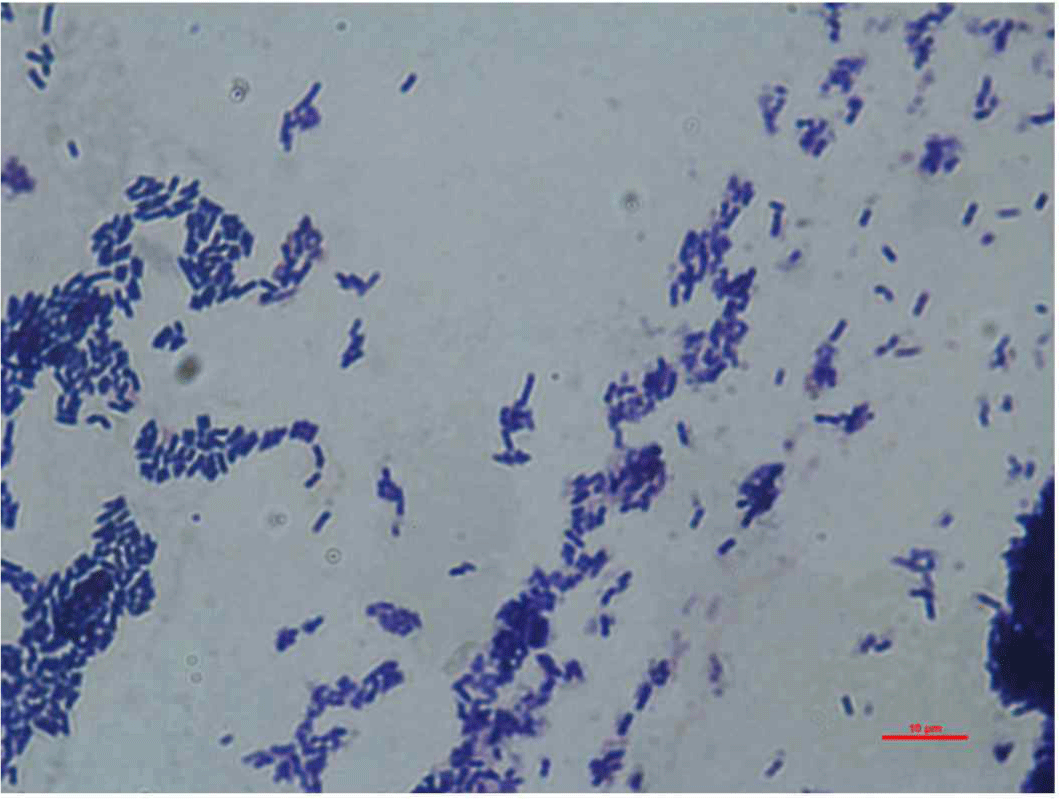
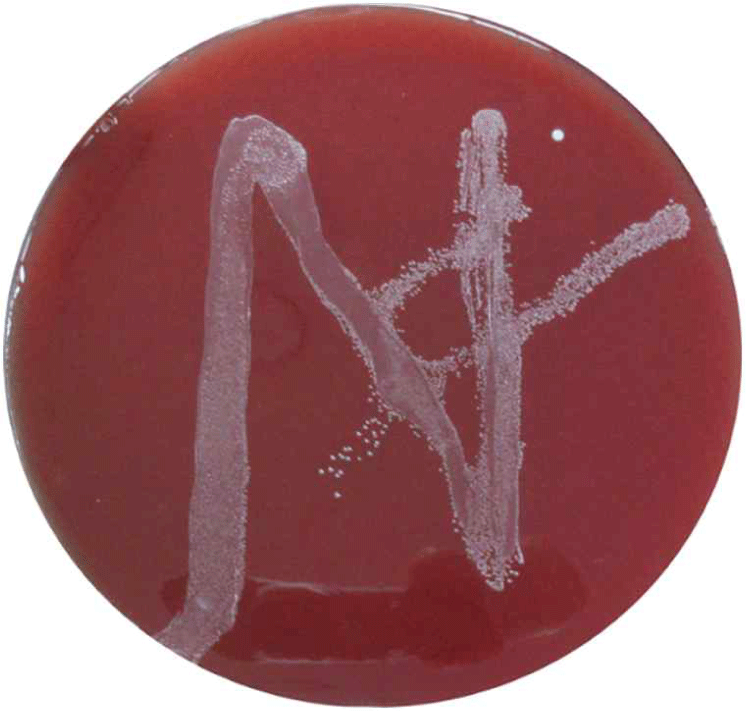
L. argentoratensis를 MRS broth에 접종하여 24시간 배양하였다. 배양 종료 후, 배양액은 원심분리기를 통하여 상징액을 회수하였다. 얻어진 상징액은 Syringe filter 0.22 μm(Advantec)를 사용하여 여과하였다. 이때 얻어진 상징액의 최종 pH는 3.73을 나타내었다.
블루베리 유래 유산균인 L. argentoratensis 배양 상징액의 병원성균에 대한 항균활성을 paper disc법으로 확인하였다. 병원성균인 Salmonella와 Escherichia에 대한 항균활성은 각각 Figs. 3 and 4에 나타내었다. Fig. 3은 S. Enteritidis NCCP 16947, S. Typhimurium NCCP 16960, 그리고 S. Thompson NCCP 11704에 대한 항균활성을 측정한 결과이다. L. argentoratensis로부터 얻어진 상징액은 시험에 이용된 3종의 Salmonella에 대하여 40과 20 μL의 농도에서 현저한 항균활성을 나타내었다. 한편, Fig. 4는 E. coli KCCM 11569, E. coli KCCM 11587, E. coli KCCM 11591, E. coli KCCM 11596, 그리고 E. coli 11600에 대하여 L. argentoratensis 배양 상징액의 항균활성을 나타낸 결과이다. Escherichia에 대하여 Salmonella의 항균결과와 같이 40과 20 μL의 농도에서 현저한 항균활성을 나타내었다. 따라서 블루베리 유래 L. argentoratensis로부터 얻어진 상징액은 병원성균인 Salmonella와 Escherichia의 성장을 억제하였다.
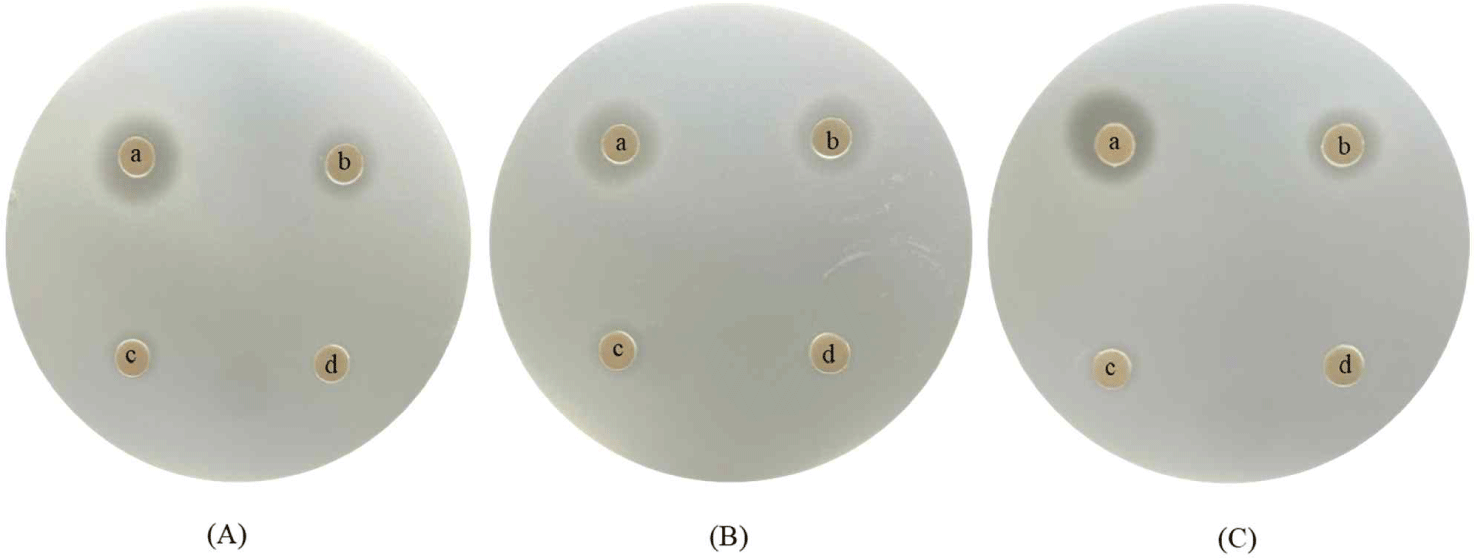

블루베리유래 L. argentoratensis로부터 얻어진 배양 상징액의 항균 활성 농도를 측정하기 위해 96 well plate법을 이용하여 측정하였다. Figs. 5 and 6은 병원성균에 대하여 L. argentoratensis의 배양 상징액을 20%, 10%, 5%, 2.5% 농도로 첨가한 후, 24시간 동안 균의 성장을 측정한 결과이다. Fig. 5는 S. Enteritidis NCCP 16947, S. Typhimurium NCCP 16960 및 S. Thompson NCCP 11704에 대한 블루베리유래 L. argentoratensis의 배양 상징액의 항균 활성을 나타내었다. L. argentoratensis로부터 얻은 상징액은 20%와 10% 첨가 농도에서 시험에 이용된 S. Enteritidis NCCP 16947, S. Typhimurium NCCP 16960 및 S. Thompson NCCP 11704 모두에서 배양초기부터 배양 종료까지 성장이 현저하게 억제되었다(Fig. 5). 5% 농도에서는 S. Typhimurium NCCP 16960과 S. Thompson NCCP 11704에서 배양 9시간까지 성장이 억제되었다(Fig. 5B and C). 그러나 S. Enteritidis NCCP 16947은 대조구보다는 성장이 억제되었지만, S. Typhimurium NCCP 16960과 S. Thompson NCCP 11704에 비해 높은 성장을 나타내었다(Fig. 5A). 그리고 2.5%의 농도에서는 S. Enteritidis NCCP 16947, S. Typhimurium NCCP 16960, 그리고 S. Thompson NCCP 11704 모두에서 약간의 성장 억제를 보여주었다(Fig. 5).

한편, Fig. 6은 E. coli KCCM 11569, E. coli KCCM 11587, E. coli KCCM 11591, E. coli KCCM 11596 및 E. coli 11600에 대한 항균 활성을 나타내었다. 시험에 사용된 5종의 대장균은 모두 20%와 10% 농도에서 배양 초기부터 24시간까지 현저한 항균 활성을 보여주었다(Fig. 6). 5%의 농도에서 E. coli KCCM 11596은 배양 15시간, E. coli KCCM 11587은 배양 12시간, E. coli 11600은 배양 9시간까지, 그리고 E. coli KCCM 11659와 E. coli KCCM 11591은 배양 3시간까지 억제되었다(Fig. 6). 한편, 2.5% 농도에서는 모든 시험구에서 약간의 성장 억제를 보여주었다(Fig. 6).
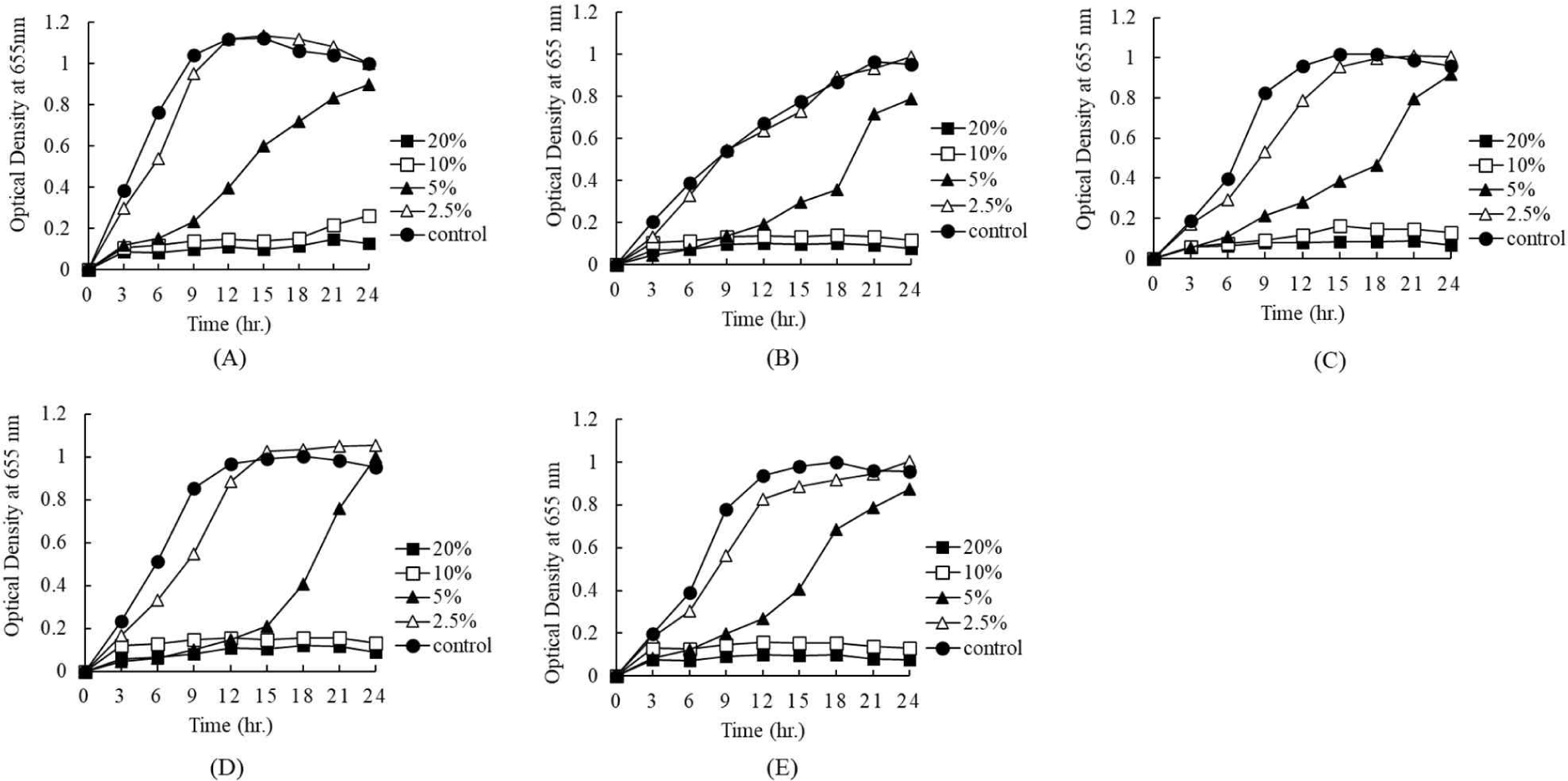
블루베리유래 L. argentoratensis로부터 얻어진 배양 상징액의 항균 활성이 열에 대하여 안정한지를 알아보기 위하여 배양 상징액을 각각 65°C에서 30 min, 75°C에서 15 min, 85°C에서 10 min, 100°C에서 5 min의 조건으로 열처리한 후, 5% 첨가에 의해서 병원성 균주에 대한 항균활성을 측정하였다. Fig. 7은 L. argentoratensis로부터 얻어진 배양 상징액을 S. Enteritidis NCCP 16947, S. Thompson NCCP 11704, 그리고 S. Typhimurium NCCP 16960에 첨가한 후, 성장을 나타낸 결과이다. 모든 온도 처리구에서 온도 처리하지 않은 대조구와 같은 항균활성을 보여주었다(Fig. 7). 한편, Fig. 8은 L. argentoratensis로부터 얻어진 배양 상징액을 각각의 온도에서 열처리한 후, E. coli KCCM 11587, E. coli KCCM 11591, E. coli KCCM 11596, 그리고 E. coli KCCM 11600에 첨가하여 배양 24시간 동안 성장을 측정한 결과이다. 시험에 이용된 각각의 Escherichia는 모든 온도 처리구에서 온도 처리하지 않은 대조구와 같은 항균활성을 보여주었다(Fig. 8). 따라서 L. argentoratensis로부터 얻어진 배양 상징액의 병원성균에 대한 항균물질은 열에 안정한 것을 보여주었다.


블루베리로부터 분리된 L. argentoratensis로부터 얻어진 배양 상징액의 pH는 3.73으로 측정되었다. 배양 상징액의 항균활성이 유기산에 의한 것인지, bacteriocin에 의한 것인지를 알아보기 위해 1N NaOH를 사용하여 배양 상징액을 pH 7.0로 조정하였다. Fig. 9는 배양 상징액을 pH 7.0으로 조정하여 배지에 첨가 후, 96 well plate 법을 이용하여 S. Enteritidis NCCP 16947, S. Thompson NCCP 11704, 그리고 S. Typhimurium NCCP 16960의 성장을 나타낸 결과이다. 상징액을 pH 7.0으로 조정 후 배지에 첨가하여 배양한 결과, Salmonella에 대한 배양 상징액의 항균활성은 나타나지 않았다. 그러나 배양 상징액의 pH를 조정하지 않은 시험구는 Salmonella에 항균활성을 나타낸 것으로 보아 성장억제 작용은 유기산에 의한 결과라고 판단된다. 한편 Fig. 10은 배양 상징액을 pH 7.0으로 조정하여 배지에 첨가 후 E. coli KCCM 11569, E. coli KCCM 11587, E. coli KCCM 11591, E. coli KCCM 11596, 그리고 E. coli KCCM 11600의 성장을 측정한 결과이다. 모든 시험구에서 배양 상징액의 pH를 7.0으로 조정하였을 때, 항균활성은 나타나지 않았다(Fig. 10). 이와 같은 결과는 Salmonella와 같은 결과를 보여주었다.

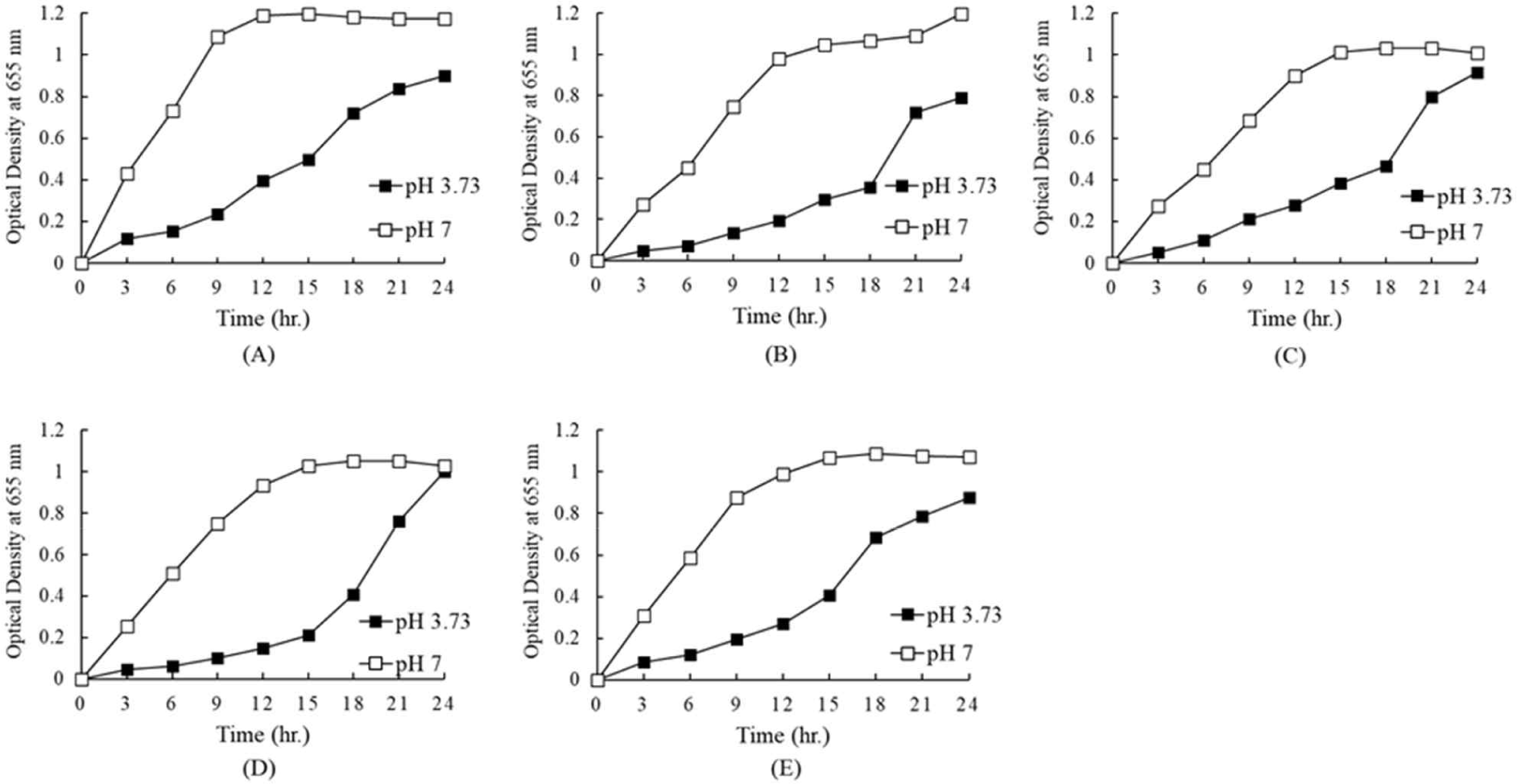
이전 우리는 쪽파로부터 Lactiplantibacillus plantarum을 분리하여 병원성균에 대한 항균활성을 확인하였다[26]. 본 연구에서도 쪽파로부터 분리된 Lactiplantibacillus plantarum의 배양 상징액의 pH변화에 있어서는 성장 억제 효과가 없는 반면, 열변성에 의해서는 병원성균의 성장을 억제하였다는 보고와 같은 결과를 보여주었다. 최근 건강기능식품의 소재개발이 현저하게 연구되고 있다. 특히 유가공 분야의 프로바이오틱스의 시장 규모는 빠른 속도로 증가하고 있다. Lim et al.[27]은 전통김치로부터 Lactobacillus plantarum KC23을 분리·동정하였고, 이 유산균은 병원성균인 S. Typhimurium, Listeria monocytogenes, Staphylococcus aureus, Bacillus cereus 그리고 E. coli에 대하여 항균활성을 측정한 결과, 모두에게 항균효과를 보여주었다고 하였다. 그리고 Kim and Lim[28]은 김치로부터 분리된 L. plantarum KI69의 기능성 식품에 적용가능 여부를 시험하였다. L. plantarum KI69는 병원성균인 E. coli, S. Typhimurium, L. monocytogenes, S. aureus 그리고 B. cereus에 대하여 항균활성을 측정한 결과, 각각 15.44%, 50.79%, 58.62%, 37.85%로서 L. monocytogenes에서 가장 억제효과가 높았다고 하였다. 그리고 그들은 시험에 이용된 병원성균들이 각각 항균력이 다른 이유는 pH 강하, 산화환원 전위의 감소, 유해균과의 경쟁적 영양성분 소비, 과산화수소의 생성, 유기산의 종류, 박테리오신 등의 억제요소에 기인한다고 하였다. 따라서 우리들의 연구에서 병원성균에 대한 항균활성은 배양액을 pH 7.0으로 조정하였을 경우, 항균활성이 나타나지 않은 것으로 보아 유기산에 의한 항균효과가 가장 크다고 판단된다. 그러나 L. argentoratensis로부터 박테리오신이 생산되지 않는다고는 아직 판단하기 이르다. 왜냐하면 첫째, L. argentoratensis에 있어서 박테리오신의 생산조건 즉, 배지내 구성성분, 균체량, Tween20과 Tween 80 첨가 조건 등에 따라 항균활성에 영향을 미칠 수 있다[29–31]. 둘째, 본 실험 결과 항균활성은 열안정성을 보였기 때문에 일부 박테리오신은 열에 안정한 소형(<5kDa)의 펩타이드일 가능성도 있기 때문이다[32]. 따라서 우리들은 차후 L. argentoratensis의 배양 상징액을 농축하여 Tricine-SDS-PAGE에 의한 박테리오신의 활성 여부, 그리고 PCR에 의한 박테리오신 존재 여부 등을 관찰할 예정으로 있다.
본 연구에서 L. argentoratensis로부터 얻어진 배양 상징액이 Salmonella와 Escherichia에 대하여 항균활성과 hemolysis시험에 대한 음성 결과와 같이 충분히 발효유제품 및 생균제로 이용 시 장내균총을 충분히 개선할 것으로 사료된다. 따라서 차기 연구에서는 블루베리로부터 분리된 L. argentoratensis의 발효용 스타터로서 이용가능성, 병원성균에 대한 유기산에 의한 항균활성 이외에 박테리오신 규명, 그리고 장내 부착성 등의 추가적인 연구를 통하여 산업적 이용가치를 높일 필요성이 있다.
요 약
본 연구는 블루베리(Vaccinium)로부터 유산균을 분리하였다. 분리된 유산균은 호기와 혐기에서 모두 성장이 가능하였고, 그람염색에 의해 확인한 결과, 형태는 간상형이며, 그람 양성임을 확인하였다. 또한 균을 동정한 결과, L. argentoratensis와 높은 상동성을 나타내었다. 이 균으로부터 배양 상징액을 분리하여 병원성균인 Salmonella와 Escherichia에 대한 항균활성을 측정하였다. 시험에 이용된 Salmonella는 S. Enteritidis NCCP 16947, S. Typhimurium NCCP 16960 그리고 S. Thompson NCCP 11704로 L. argentoratensis의 배양 상징액은 이들의 성장을 현저히 억제하였다. 특히 배양 상징액의 농도가 높을수록 항균활성은 증가하였다. 더욱이 E. coli strains(E. coli KCCM 11569, E. coli KCCM 11587, E. coli KCCM 11591, E. coli KCCM 11596, E. coli KCCM 11600)에 대한 항균활성도 Salmonella의 결과와 같이 농도가 높을수록 현저한 항균활성을 보여주었다. 항균물질이 열과 pH에 안정한지를 알아보기 위하여 유산균 배양 상징액을 각각 65°C에서 30 min, 75°C에서 15 min, 85°C에서 10 min, 100°C에서 5 min의 조건으로 열처리한 후, 5% 첨가에 의해서 병원성 균주에 대한 항균활성을 측정한 결과 열처리전과 동일한 항균활성을 보여주었다. 그러나 배양 상징액의 pH 3.73을 7.0으로 조정한 시험에서는 항균활성을 나타내지 않았다. 따라서 병원성균에 항균활성을 나타내는 물질은 열에 안정하고 pH변화에는 불안정한 것을 보여주었다.
